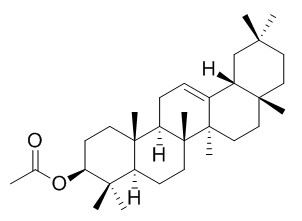Genus and Species: Asclepias syriaca
Habitat: Native to southern Canada and continental United Sates east of the Rocky Mountains. Grows along banks or flood plains of lakes, ponds, and waterways, in prairies, forest margins, roadsides, and waste places.
Seasons: Blooms June- August. Seedlings bloom the second year. Stems collected around fall and winter for maximum hardness to make rope, but sturdy cord can still be made all season long.
Active Chemical Ingredeient: Beta-amyrin-acetate
Chemical Structure:

Uses: Named by Carl Linnaeus after Asclepius, the Greek god of healing due to the many folk-medicinal uses. Contains latex containing alkaloids including cardenolides. Some species are toxic, so correct identification is important.
High dextrose content leads plant to be used for emergency
diabetic attacks. Used for kidney problems, to draw out poison, asthma, female
disorders, and arthritis. Latex juice rubbed on warts or ringworm is effective.
Twisting the fiber opposite each other and twining them together forms the cord. Often this is accomplished by rolling the fibers on the thigh while twisting them together. This can create a tourniquet, which stops bleeding.
Twisting the fiber opposite each other and twining them together forms the cord. Often this is accomplished by rolling the fibers on the thigh while twisting them together. This can create a tourniquet, which stops bleeding.

No comments:
Post a Comment